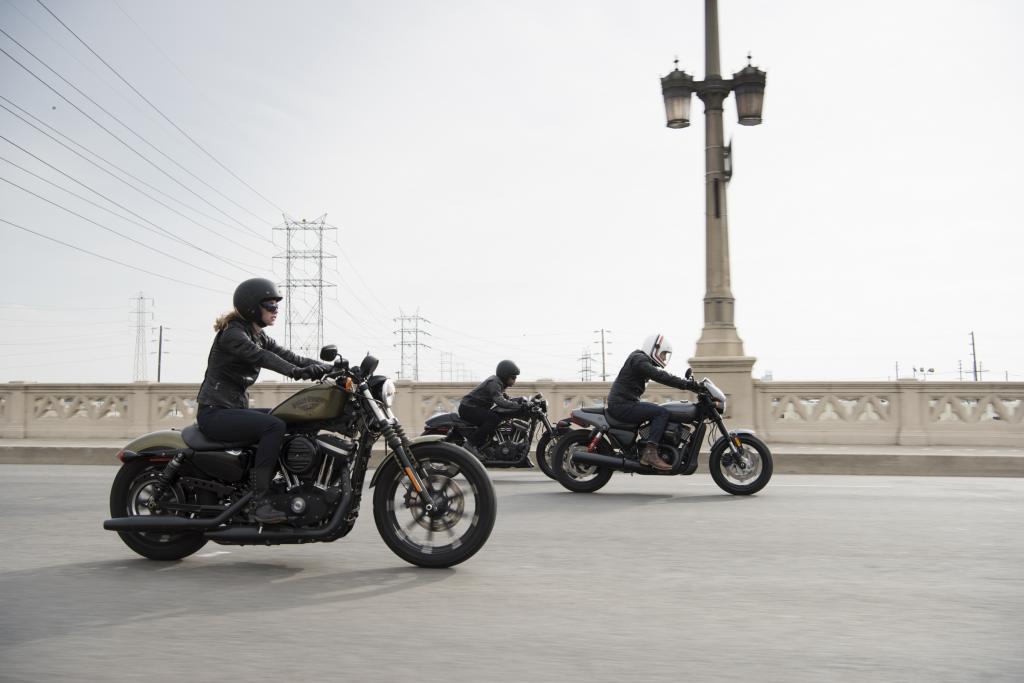Harley-Davidson Announces Second Quarter 2017 Results
Company Delivered Strong Margins, Retail Sales Lower Than Expected
MILWAUKEE, July 18, 2017 – Harley-Davidson, Inc.(NYSE:HOG) second quarter 2017 diluted EPS decreased 4.5 percent to $1.48 compared to $1.55 in the second quarter of 2016. Second quarter net income was $258.9 million on consolidated revenue of $1.77 billion versus net income of $280.4 millionon consolidated revenue of$1.86 billion for the same period in 2016.
“We are pleased with our ability to deliver strong margins in the quarter despite challenging market conditions, particularly in the U.S.,” said Matt Levatich, president and CEO, Harley-Davidson. “Given U.S. industry challenges in the second quarter and the importance of the supply and demand balance for our premium brand, we are lowering our full-year shipment and margin guidance.”
Harley-Davidson worldwide retail motorcycle sales were down 6.7 percent in the second quarter compared to the same period in 2016. Harley-Davidson retail motorcycle sales in the U.S. were down 9.3 percent compared to the year-ago quarter, with the overall U.S. industry down for the same period. Harley-Davidson’s U.S. market share for the quarter was 48.5 percent in the 601cc-plus segment. Harley-Davidson’s international retail sales decreased 2.3 percent compared to the second quarter in 2016.
Through six months, Harley-Davidson’s 2017 diluted EPS was $2.53, down 13.1 percent from $2.91 in the year-ago period. For the first six months, Harley-Davidson’s 2017 net income was $445.2 million on consolidated revenue of $3.27 billion compared to six-month 2016 net income of $530.9 million on consolidated revenue of $3.61 billion. Through six months, worldwide retail motorcycle sales were down 5.7 percent from the same period in 2016.
“Our long-term strategy, focused on building the next generation of Harley-Davidson riders, is our true north. Our new product investment is one pillar of our long-term strategy to build riders globally and we are energized by the strength of our model year 2018 motorcycles coming later this summer,” said Levatich.
Harley-Davidson Retail Motorcycle Sales
| In units as reported by H-D dealers | 2nd Quarter | Six Months | ||||
| 2017 | 2016 | Change | 2017 | 2016 | Change | |
| U.S. | 49,668 | 54,786 | (9.3)% | 82,984 | 90,112 | (7.9)% |
| Canada | 3,827 | 3,813 | 0.4% | 6,188 | 6,283 | (1.5)% |
| Latin America | 2,355 | 2,573 | (8.5)% | 4,697 | 4,459 | 5.3% |
| EMEA | 17,230 | 17,513 | (1.6)% | 27,397 | 27,723 | (1.2)% |
| Asia Pacific | 8,308 | 8,581 | (3.2)% | 15,171 | 16,147 | (6.0)% |
| International Total | 31,720 | 32,480 | (2.3)% | 53,453 | 54,612 | (2.1)% |
| Worldwide Total | 81,388 | 87,266 | (6.7)% | 136,437 | 144,724 | (5.7)% |
Harley-Davidson new retail motorcycle sales in the U.S. were down primarily driven by weak industry conditions. New retail sales internationally were also down but generally in-line with company expectations for the second quarter of 2017.
Motorcycles and Related Products Segment Results
| $ in thousands | 2nd Quarter | Six Months | ||||
| 2017 | 2016 | Change | 2017 | 2016 | Change | |
| Motorcycle Shipments (vehicles) | 81,807 | 88,160 | (7.2)% | 152,638 | 171,196 | (10.8)% |
| Revenue | ||||||
| Motorcycles | $1,270,433 | $1,330,632 | (4.5)% | $2,370,135 | $2,648,210 | (10.5)% |
| Parts & Accessories | $237,498 | $258,208 | (8.0)% | $406,523 | $441,913 | (8.0)% |
| General Merchandise | $63,017 | $75,757 | (16.8)% | $118,853 | $146,375 | (18.8)% |
| Gross Margin | 36.5% | 36.4% | 0.1pts | 36.2% | 36.9% | (0.7)pts |
| Operating Income | $319,647 | $322,749 | (1.0)% | $558,489 | $655,206 | (14.8)% |
| Operating Margin | 20.3% | 19.3% | 1.0pts | 19.2% | 20.2% | (1.0)pts |
Revenue from the Motorcycles and Related Products segment was down in the second quarter of 2017 versus prior year largely due to lower motorcycle shipments. Operating margin as a percent of revenue increased versus the prior year quarter primarily as a result of mix favorability driven by demand for the Milwaukee-Eight powered touring motorcycles and lower SG&A spending.
Financial Services Segment Results
| $ in thousands | 2nd Quarter | Six Months | ||||
| 2017 | 2016 | Change | 2017 | 2016 | Change | |
| Revenue | $188,034 | $190,964 | (1.5)% | $361,255 | $364,322 | (0.8)% |
| Operating Income | $81,935 | $89,573 | (8.5)% | $134,571 | $145,944 | (7.8)% |
The Financial Services segment operating income was down 8.5 percent due to the full securitization gain on sale recognized during the second quarter of 2016 which did not recur in the second quarter of 2017.
Income Tax Rate
For the first half of 2017, Harley-Davidson’s effective tax rate was 34.4 percent compared to 32.7 percent in the prior year period. The company continues to expect its full-year 2017 effective tax rate to be approximately 34.5 percent.
Other Results
Cash and marketable securities totaled $988.5 million at the end of the quarter, compared to $869.7 million in the year-ago quarter. During the first six months of 2017, Harley-Davidsongenerated $627.1 million of cash from operating activities compared to$456.3 million for the first half of 2016. The company paid a cash dividend of $0.365 per share for the second quarter of 2017, and a cumulative total of $0.73 for the first six months of 2017. On a discretionary basis, the company repurchased 3.0 million shares of its common stock during the second quarter of 2017 for $163.2 million. In the second quarter of 2017, there were approximately 175.3 million weighted-average diluted common shares outstanding, compared to 181.3 million shares in the same period a year ago. At the end of the period, 15.0 million shares remained on a board-approved share repurchase authorization.
Guidance
Harley-Davidson is revising its full-year guidance for motorcycle shipments and now expects to ship 241,000 to 246,000 motorcycles to dealers worldwide in 2017, which is down approximately 6 percent to 8 percent from 2016. The company had previously provided full-year shipment guidance of flat to down modestly in comparison to 2016. In the third quarter, the company expects to ship 39,000 to 44,000 motorcycles, which is down approximately 10 percent to 20 percent from 2016. The company now expects full-year 2017 operating margin to be down approximately 1 percentage point compared to 2016. The company continues to expect 2017 capital expenditures to be $200 million to $220 million.
Company Background
Harley-Davidson, Inc. is the parent company of Harley-Davidson Motor Company and Harley-Davidson Financial Services. Since 1903, Harley-Davidson Motor Company has fulfilled dreams of personal freedom with custom, cruiser and touring motorcycles, riding experiences and events and a complete line of Harley-Davidson motorcycle parts, accessories, general merchandise, riding gear and apparel. Harley-Davidson Financial Services provides wholesale and retail financing, insurance, extended service and other protection plans and credit card programs to Harley-Davidson dealers and riders in the U.S., Canada and other select international markets. For more information, visit Harley-Davidson’s Web site at www.harley-davidson.com.
Conference Call and Webcast Presentation
Harley-Davidson will discuss second quarter results on a Webcast at 8:00 a.m. CT today. The supporting slides will be posted prior to the call and can be accessed at http://investor.harley-davidson.com under the Events and Presentations section. The audio portion of today’s call will also be posted approximately two hours after the call concludes.
Forward-Looking Statements
The company intends that certain matters discussed in this release are “forward-looking statements” intended to qualify for the safe harbor from liability established by the Private Securities Litigation Reform Act of 1995. These forward-looking statements can generally be identified as such because the context of the statement will include words such as the company “believes,” “anticipates,” “expects,” “plans,” or “estimates” or words of similar meaning. Similarly, statements that describe future plans, objectives, outlooks, targets, guidance or goals are also forward-looking statements. Such forward-looking statements are subject to certain risks and uncertainties that could cause actual results to differ materially, unfavorably or favorably, from those anticipated as of the date of this release. Certain of such risks and uncertainties are described below. Shareholders, potential investors, and other readers are urged to consider these factors in evaluating the forward-looking statements and cautioned not to place undue reliance on such forward-looking statements. The forward-looking statements included in this release are only made as of the date of this release, and the company disclaims any obligation to publicly update such forward-looking statements to reflect subsequent events or circumstances.
The company’s ability to meet the targets and expectations noted depends upon, among other factors, the company’s ability to (i) execute its business strategy, (ii) drive demand by executing its marketing strategy of appealing to and growing sales to multi-generational and multi-cultural customers worldwide in an increasingly competitive marketplace, (iii) develop and introduce products, services and experiences that are successful in the marketplace, (iv) manage the impact that prices for and supply of used motorcycles may have on its business, including on retail sales of new motorcycles, (v) balance production volumes for its new motorcycles with consumer demand, including in circumstances where competitors may be supplying new motorcycles to the market in excess of demand at reduced prices, (vi) manage through changes in general economic and business conditions, including changing capital, credit and retail markets, and the changing political environment, (vii) manage risks that arise through expanding international manufacturing, operations and sales, (viii) accurately estimate and adjust to fluctuations in foreign currency exchange rates, interest rates and commodity prices, (ix) manage the credit quality, the loan servicing and collection activities, and the recovery rates of HDFS’ loan portfolio, (x) prevent and detect any issues with its motorcycles or any associated manufacturing processes to avoid delays in new model launches, recall campaigns, regulatory agency investigations, increased warranty costs or litigation and adverse effects on its reputation and brand strength, (xi) retain and attract talented employees, (xii) prevent a cybersecurity breach involving consumer, employee, dealer, supplier, or company data and respond to evolving regulatory requirements regarding data security, (xiii) continue to develop the capabilities of its distributors and dealers and manage the risks that its independent dealers may have difficulty obtaining capital and managing through changing economic conditions and consumer demand, (xiv) adjust to tax reform, healthcare inflation and reform and pension reform, (xv) manage through the effects inconsistent and unpredictable weather patterns may have on retail sales of motorcycles, (xvi) manage supply chain issues, including quality issues and any unexpected interruptions or price increases caused by raw material shortages or natural disasters, (xvii) implement and manage enterprise-wide information technology systems, including systems at its manufacturing facilities, (xviii) manage changes and prepare for requirements in legislative and regulatory environments for its products, services and operations, (xix) manage its exposure to product liability claims and commercial or contractual disputes, (xx) execute its flexible production strategy, (xxi) successfully access the capital and/or credit markets on terms (including interest rates) that are acceptable to the company and within its expectations, and (xxii) continue to manage the relationships and agreements that the company has with its labor unions to help drive long-term competitiveness.
In addition, the company could experience delays or disruptions in its operations as a result of work stoppages, strikes, natural causes, terrorism or other factors. Other factors are described in risk factors that the company has disclosed in documents previously filed with the Securities and Exchange Commission.
The company’s ability to sell its motorcycles and related products and services and to meet its financial expectations also depends on the ability of the company’s independent dealers to sell its motorcycles and related products and services to retail customers. The company depends on the capability and financial capacity of its independent dealers and distributors to develop and implement effective retail sales plans to create demand for the motorcycles and related products and services they purchase from the company. In addition, the company’s independent dealers and distributors may experience difficulties in operating their businesses and selling Harley-Davidson motorcycles and related products and services as a result of weather, economic conditions or other factors.






